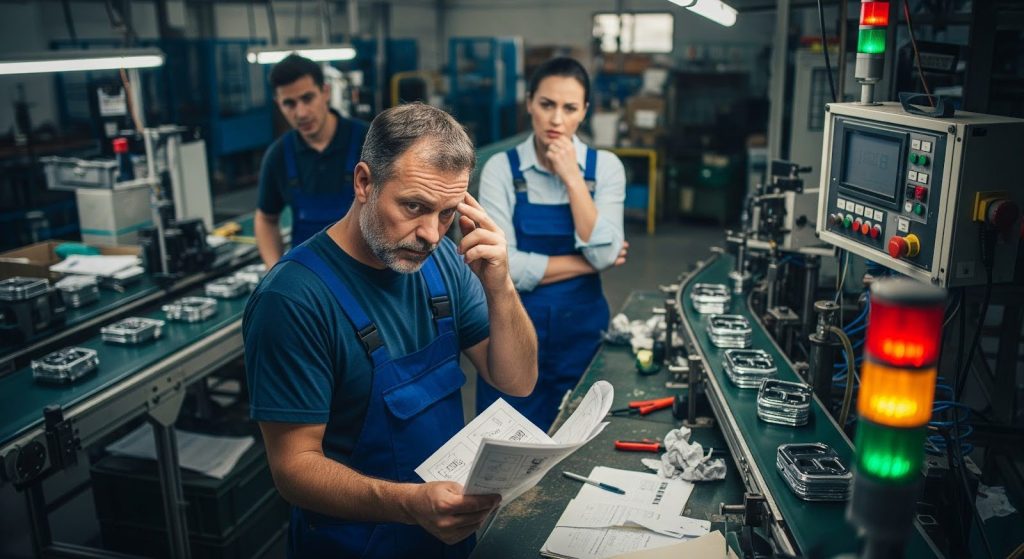Das verarbeitende Gewerbe hat in den letzten Jahrzehnten einen dramatischen Wandel durchgemacht. Jetzt steht sie vor ihrer größten Herausforderung - der wachsenden Qualifikationslücke. Die Automatisierung spielt eine entscheidende Rolle in der Produktion. Das bedeutet, dass viele Aufgaben, die früher von Facharbeitern erledigt wurden, jetzt von Maschinen übernommen werden.

Glücklicherweise sind die Arbeiter nicht vollständig durch automatisierte Systeme ersetzt worden. Geschulte, gut ausgebildete Mitarbeiter sind für die Fertigungsindustrie so wichtig wie eh und je, auch wenn sich ihre Aufgaben ändern. Aber sie sollten neue Wege finden, um einen Mehrwert zu schaffen, und kontinuierlich Fachwissen entwickeln, das nicht an Maschinen abgegeben werden kann.
Die Arbeitgeber wollen ihren Arbeitnehmern helfen, neue Fähigkeiten zu entwickeln, aber viele wissen nicht, wie sie ihr Personal weiterbilden können, ohne die Produktion zu stoppen oder Mitarbeiter von ihren Posten abzuziehen. Wenn die Hersteller keine Lösungen finden, wird die Qualifikationslücke, die die Branche bedroht, wahrscheinlich auch in Zukunft bestehen bleiben.
Ausmaß des Problems der Qualifikationslücke
Die National Association of Manufacturers (NAM) erklärt, dass in den nächsten zehn Jahren voraussichtlich zwei Millionen Arbeitsplätze in der verarbeitenden Industrie unbesetzt bleiben werden. Nach Angaben des Manufacturing Institute berichten 80 Prozent der Hersteller von einem erheblichen Mangel an qualifizierten Bewerbern. Dies gilt auch für Stellen in der Wartungsabteilung.
Der Mangel an qualifizierten Wartungsfachkräften stellt das verarbeitende Gewerbe vor eine dreifache Herausforderung. Erstens geht die Generation der Baby-Boomer mit einer Rate von 10.000 Arbeitnehmern pro Tag in den Ruhestand. Dies könnte dazu führen, dass in den nächsten zehn Jahren jedes Jahr mehr als 10.000 erfahrene Wartungsfachleute die Fertigungsbetriebe verlassen. Viele Produktionsbetriebe Wissen wird mit ihnen gehen. Darüber hinaus werden die offenen Stellen im Bereich der industriellen Wartung bis 2024 um 16 Prozent zunehmen.
Technologie nutzen, um die Qualifikationslücke zu schließen
Führungskräfte und CEOs verstehen das Problem, aber viele sind ratlos, was sie dagegen tun sollen. Wie kann der Betrieb weiterhin reibungslos funktionieren und die Produktionsziele erreichen, wenn die Mitarbeiter jeden Tag stundenlang in den Klassenzimmern sitzen?
Die Technologie, die in gewissem Maße die Qualifikationslücke vergrößert und andere Herausforderungen für die Hersteller mit sich gebracht hat, bietet auch Lösungen. Jetzt, wo alles in der Fabrik vernetzt ist, kann dies auch für die Ausbildung gelten.
Einsatz von Augmented Reality in der Fertigung
Augmented Reality (AR), bei der digitale Informationen in die reale Welt eingeblendet werden, und Virtual Reality (VR), die eine immersive, digitale Umgebung bietet, bieten leistungsstarke Lernwerkzeuge. VR- und AR-Programme sind eine Möglichkeit, den Unterricht dorthin zu bringen, wo er benötigt wird, anstatt die Mitarbeiter zu zwingen, ihre Arbeit liegen zu lassen, um an Kursen teilzunehmen. Für Hersteller, denen es wichtig ist, das Produktionstempo während der Schulungen aufrechtzuerhalten, bietet AR eine praktikable Option. Die Verwendung eines Telefons oder Headsets (wie MSFT Hololens) können die Mitarbeiter an ihrem Arbeitsplatz bleiben - und sogar Maschinen bedienen - während sie lernen.

Lektionen zu komplexer Montage, Wartung, Expertenunterstützung, Risikominderung und Qualitätssicherung - alles Bereiche, die sich weiterhin schnell verändern - können dem Mitarbeiter über AR vermittelt werden, während er mit diesen Aufgaben beschäftigt ist. Und wenn neue Lektionen hinzugefügt werden, können diese einfach auf das AR-Gerät gestreamt werden, ohne dass die Arbeit oder die Produktion verlangsamt wird.
Einsatz von virtueller Realität in der Fertigung
VR ist auch ein effektives Lernwerkzeug, insbesondere wenn es um Fertigungsprozesse geht, die eine physische Gefahr für die Arbeiter darstellen. Anstatt am Arbeitsplatz zu lernen, wo die Gefahr besteht, Fehler zu machen, können die Arbeitnehmer in virtuellen Umgebungen für schwierige Aufgaben trainieren.
Intelligente Gadgets haben eine Welt voller neuer Herausforderungen für die Hersteller geschaffen. Aber wenn es darum geht, den Fachkräftemangel zu beheben, können vernetzte Geräte innovative Lösungen bieten. Dennoch wird menschliches Fachwissen für Unternehmen immer das A und O sein, um wettbewerbsfähig zu bleiben.
AR und VR bieten Möglichkeiten, die Fähigkeiten der Mitarbeiter zu verbessern, ohne die Produktion zu verlangsamen, und die Hersteller sollten diese Mittel erforschen, damit die Mitarbeiter im Zentrum des Betriebs bleiben können, während die Industrie 4.0 voranschreitet.
